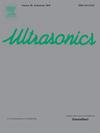Intraoperative HIFU ablation of the liver at the hepatocaval confluence as adjunct to surgery: Preliminary animal experiments
IF 3.8
2区 物理与天体物理
Q1 ACOUSTICS
引用次数: 0
Abstract
Treating colorectal liver metastases (CLMs) located at the hepatocaval confluence with surgery is challenging due to its complexity and associated high risks of perioperative mortality and morbidity. Moreover, thermal ablation techniques are sensitive to the “heat-sink” effect, which reduces their efficacy when tumors are in contact with major blood vessels. In this study we evaluated the feasibility and safety of an intraoperative high-intensity focused ultrasound (HIFU) device for destroying liver tissue volumes sufficiently large to consider treating CLMs at the hepatocaval confluence. Experiments were conducted on six pigs that were followed up to 19 days after the treatment. One HIFU ablation in each animal was created using a 370 s exposure at 100 W. Homogeneous HIFU ablations of liver tissues were safely created at the hepatocaval confluence around the hepatic veins (HVs) in all animals. The targeted HVs were similar to those of humans, with an average diameter of 9.1 ± 1.4 mm. The longest and shortest axes of the HIFU ablations were on average 44.5 ± 11.5 mm and 26.7 ± 4.9 mm, respectively. These values indicate that this device could destroy CLMs up to 2 cm in diameter. Doppler acquisitions, MRI and histological analysis confirmed that HIFU ablations were in contact with the inferior vena cava and extended to the HV wall and that blood flow was maintained. This in vivo preclinical study showed that intraoperative HIFU destruction of liver tissues at the hepatocaval confluence under Doppler ultrasound guidance could therefore represent a new therapeutic option for CLMs.
术中肝空腔汇合处肝HIFU消融辅助手术:初步动物实验。
由于其复杂性和围手术期死亡率和发病率的高风险,手术治疗位于肝下腔汇合处的结直肠肝转移(CLMs)具有挑战性。此外,热消融技术对“热沉”效应很敏感,当肿瘤与主要血管接触时,这种效应会降低其疗效。在这项研究中,我们评估了术中高强度聚焦超声(HIFU)设备用于破坏足够大的肝组织体积以考虑治疗肝空腔汇合处的CLMs的可行性和安全性。实验在6头猪身上进行,治疗后随访至19天。每只动物进行一次HIFU消融,使用370秒的100w照射。在所有动物肝静脉(HVs)周围的肝空腔汇合处安全地建立了均匀的肝组织HIFU消融。目标hv与人类相似,平均直径为9.1±1.4 mm。HIFU消融的最长和最短轴平均分别为44.5±11.5 mm和26.7±4.9 mm。这些值表明该装置可以破坏直径达2厘米的clm。多普勒成像、MRI和组织学分析证实HIFU消融与下腔静脉接触并延伸至HV壁,血流保持。这项体内临床前研究表明,在多普勒超声引导下,术中HIFU在肝空腔汇合处破坏肝组织可能是CLMs的一种新的治疗选择。
本文章由计算机程序翻译,如有差异,请以英文原文为准。
求助全文
约1分钟内获得全文
求助全文
来源期刊

Ultrasonics
医学-核医学
CiteScore
7.60
自引率
19.00%
发文量
186
审稿时长
3.9 months
期刊介绍:
Ultrasonics is the only internationally established journal which covers the entire field of ultrasound research and technology and all its many applications. Ultrasonics contains a variety of sections to keep readers fully informed and up-to-date on the whole spectrum of research and development throughout the world. Ultrasonics publishes papers of exceptional quality and of relevance to both academia and industry. Manuscripts in which ultrasonics is a central issue and not simply an incidental tool or minor issue, are welcomed.
As well as top quality original research papers and review articles by world renowned experts, Ultrasonics also regularly features short communications, a calendar of forthcoming events and special issues dedicated to topical subjects.
 求助内容:
求助内容: 应助结果提醒方式:
应助结果提醒方式:


